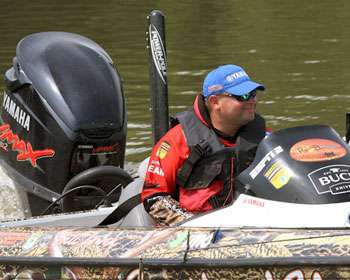
Sometimes it seems like Bill Lowen is out of place in his 21-foot Skeeter bass boat.
Wouldn't he be better off in a johnboat, a kayak or a canoe? After all, the self-proclaimed "river rat" loves to venture as far up a tributary as he can. Sure, he's been stuck once or twice, and it doesn't always pay off, but he has also engineered two Bassmaster Classic appearances largely on the strength of his willingness to go "off the grid."
None of those smaller crafts would be feasible to run on the Elite Series trail, which visits many big waters, so Lowen has learned to make a big bass boat behave like a small one. Accordingly, he rigs his new boat each year to maximize its ability to conform to his style.
When it comes to trolling motors and batteries, he's old school. "Give me the biggest ones they make," he says. "Typically, where we go, current is not such a big deal, but still, it's a lot easier to keep a 101-pound thrust motor turned down than it is to run a less powerful motor on high all day."
While he wants his boat to float shallow, he admits that he carries "more tackle than three guys could ever use." So it's not necessarily the length or weight of the boat that concerns him. He likes a wide boat that distributes that weight. "I can't believe how shallow my Skeeter will go," he says. "It floats shallower than any 19- or 20-foot boat I've ever been in."
The add-on that he's come to like most over the past year is the Power Pole anchoring system. He liked it so much he added two to his current boat. "It's hard to justify $3 grand, and I understand why a lot of people are skeptical," he says. "But I'll never own another boat without them. It's the best investment." They allow him to methodically pick apart a piece of cover without hitting the trolling motor and spooking the bass. He can hit every cranny in a laydown, every inch of a grass mat, or taunt a spawning bass until it bites, and need not worry about boat position once he gets set up in the right spot.
While it might seem illogical for an angler who prefers to fish as shallow as possible to invest big bucks in high-tech electronics, Lowen admits that here too he's gone top-of-the-line, with big screen Lowrance graphs on the bow and the console.
"You don't set them up any differently," he explains. "When I'm running up a shallow creek, the biggest key is navigation. and the Lowrance mapping is really good." When I'm in a supershallow area that I've never been before, I can follow the lines on the graph and stay in the deepest water. Without that technology, I would spend a lot more time stuck on sandbars and mud fats."
Lowen also adds a keel protector to his boats. For only a few hundred dollars, it can save the shallow water angler thousands of dollars in fiberglass work that result from pulling the boat over all sorts of nasty tangles. It also makes it easier to sell his boats at the end of the season.
With a shallow water set-up including the right weight distribution, trolling motor, power poles, electronics, and keel protector, Lowen can fish for bass that other anglers just can't reach.





